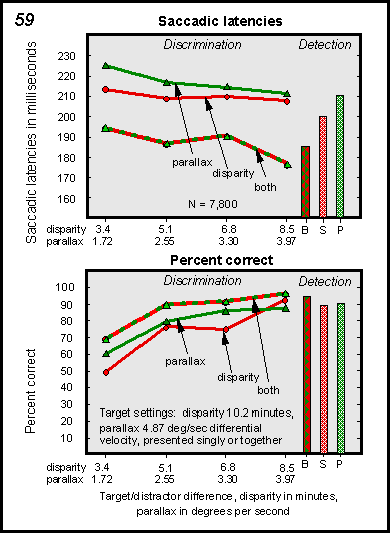The Neural
Control of Vision
L. The Processing of Depth
 Figure
59 presents data obtained from a monkey in which the animal
was trained to either detect the appearance of a single target in various
locations or to discriminate that target from three other identical targets
that appear at a lesser depth. In each case the degree of depth cues provided
was varied as indicated on the X axis. The stimuli were presented under
three conditions: stereo cues only, parallax cues only, and both cues
together. As can be seen the monkey did quite well for all these conditions,
showing a general improvement when disparity and parallax cues were increased.
Performance was best and had the shortest latencies when both stereo and
parallax cues were presented together in harmony. This was true both for
the detection and discrimination tasks. The longest reaction times occurred
when only parallax cues were provided. Maximizing speed of processing
is of course of prime importance in the world fraught with predators and
other dangers. Figure
59 presents data obtained from a monkey in which the animal
was trained to either detect the appearance of a single target in various
locations or to discriminate that target from three other identical targets
that appear at a lesser depth. In each case the degree of depth cues provided
was varied as indicated on the X axis. The stimuli were presented under
three conditions: stereo cues only, parallax cues only, and both cues
together. As can be seen the monkey did quite well for all these conditions,
showing a general improvement when disparity and parallax cues were increased.
Performance was best and had the shortest latencies when both stereo and
parallax cues were presented together in harmony. This was true both for
the detection and discrimination tasks. The longest reaction times occurred
when only parallax cues were provided. Maximizing speed of processing
is of course of prime importance in the world fraught with predators and
other dangers.
|